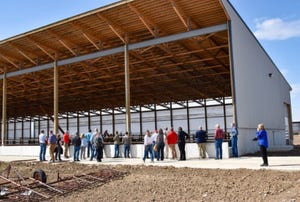20 seconds to live: Fast facts about grain engulfment
Roughly half of known grain entrapments occur on farms and half occur in commercial facilities.

Quicksand is dangerous. We've all seen the old movies where someone in a swamp sinks out of sight. You wouldn't venture near quicksand if you knew where it was. Good thing there isn't quicksand on U.S. grain farms.
But flowing grain is like quicksand. In as little as four seconds an adult can sink knee-deep in the suction of flowing grain. At this point, he or she won't be able free himself or herself without help. An adult can be completely buried by grain in 20 seconds, according to the Great Plains Center for Agricultural Health. See the video by Pioneer Rescue to see how quickly it happens.
Grain exerts forces of friction and pressure on a person that prevent self-escape. A person buried to the waist in grain requires a force equivalent to their own body weight plus 600 pounds to free them. The force required to remove a person buried under grain can exceed 2,000 pounds. Need to see it to believe it? Watch this video from an Independence, Iowa, fire department rescue grain entrapment training session.
Die in a few feet of grain
Grain engulfment has been a recognized hazard on farms and commercial grain facilities for decades. Yet both experienced and inexperienced workers and family members continue to underestimate deadly risks associated with the speed and force of flowing or shifting grain.
Anyone who enters a storage structure containing grain, or who climbs onto an outdoor grain storage pile, is at risk of being entrapped or engulfed in grain. Fatalities have occurred in as little as a few feet of grain.
Roughly half of known entrapments occur on farms and half occur in commercial facilities. Most entrapment and engulfment events occur because workers enter a bin or storage structure to check on condition of grain, or to address problems with grain flow due to spoiled grain or equipment malfunction.
Dangerous scenarios
According to the Great Plains Center for Agricultural Health, the most dangerous scenarios are:
• Flowing grain. Around 80% of reported engulfments involve a person inside a bin or storage structure when grain-unloading equipment is running. Engulfments in flowing grain also occur in outdoor grain storage piles, grain wagons, rail cars, and semi-trailers that unload from the bottom.
As unloading conveyors or augers remove grain through the bottom outlet, a funnel-shaped flow develops on the surface of the grain. Anyone standing on the surface while grain is being removed from below is at risk of being rapidly pulled down toward the outlet in the column of flowing grain. Submersion takes only seconds and once it begins, the pressure and friction forces of grain on the body are virtually impossible for victim to overcome. If grain unloading equipment is not shut off, victims can be pulled down into the unloading conveyor, auger or sump.
• Bridged grain. Spoiled or "out-of-condition" grain clumps together and can develop a crust on the top surface. This crust appears solid, but it is unstable and may hide open voids below that develop as grain is removed. Bridged grain can collapse under a person's weight, resulting in the victim being buried by falling and shifting grain. If unloading equipment is running at the time this occurs, the victim can be rapidly pulled down toward the bottom of the bin.
• Vertical grain wall avalanche. Spoiled grain can form a clumped mass that adheres to the vertical wall of a bin. Entering a bin to dislodge a vertical wall of grain that is higher than the victim is dangerous because the grain wall can suddenly break loose and fall like an avalanche, burying or injuring the victim.
• Grain vacuums. Some fatal engulfments have occurred while individuals were using grain vacuums to remove grain from bins. When the grain vacuum nozzle is placed below the grain surface, a funnel flow of grain develops as grain is sucked into the tube. An operator can be pulled into the downward flow of grain if this nozzle is released or becomes buried below the grain surface near the operator's feet. Maneuvering the vacuum tube can be awkward, increasing the operator's risk of slipping or losing balance as he tries to reposition the hose in flowing grain. If the operator falls or struggles for position, his movements can trigger an avalanche of grain if the slope of grain is steep.
About the Author(s)
You May Also Like



.png?width=300&auto=webp&quality=80&disable=upscale)
.png?width=300&auto=webp&quality=80&disable=upscale)
